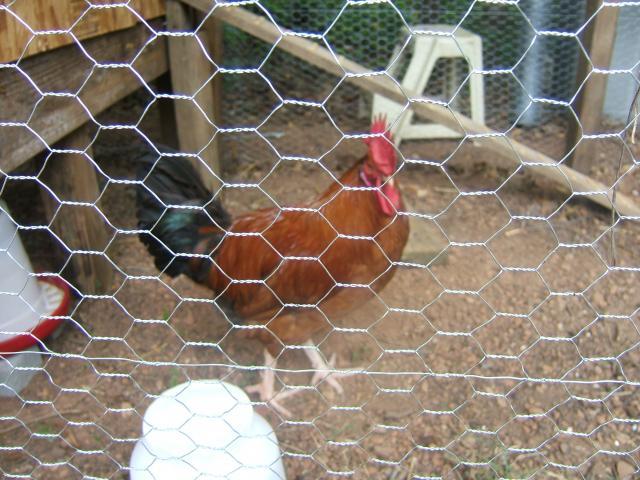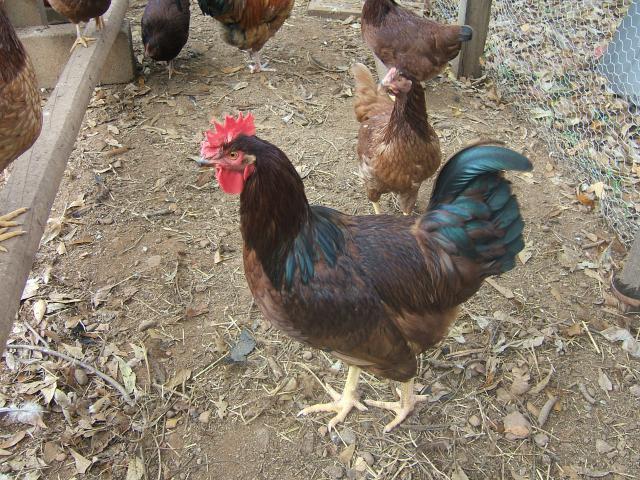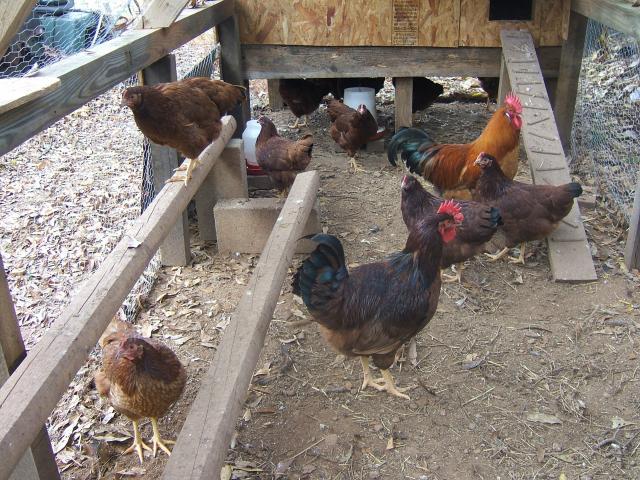- Dec 14, 2010
- 157
- 0
- 99
Thanks n advance for any help.
Back in July I bought some RIR day old chicks. One turned out to be a roo, which was good for what I wanted. Knowing I would be putting young birds out with roaming kitties around, I decided to find myself an adult, or at least a full sized rooster to keep the cats, and other predators from getting too close to the pen. Of course, newb that I am, went looking on CL for a RIR rooster. The rooster I got, as gorgeous as he is, isn't really a RIR, as you can see from the pics. The closest I found in pics on the net was a black tail buff Maran. After talking with a wonderful breeder of BTB Marans in Charleston, she agreed that he was at least mixed, and likely to be RIR/ btb Maran. He shows some RIR traits, but has the white legs and semblance of the Maran coloration. Did I mention he was a beautiful bird? He also happens to have earned his place as a great role model, teacher, and flock leader for the ladies, as well as role model for Roo, the cockerel.
My main goal, initially, was to have self sufficient flock of dual purpose birds, providing plenty of fresh eggs for the table, and once the flock is well established, meat for the table/ freezer. Though at the time I didn't fully understand the differences, the production reds suit me fine even though I love the color of the Heritage. Of course, I now have the genetic diversity of a cross, and am curious about trying my hand at breeding back to him for his coppery color and flock leading traits, without completely going away from the RIR. I would also prefer to keep the dual purpose nature I have now. My other option is to find another breed that might work well with him.
1. What was suggested to me was to breed him to the lightest colored hens to keep his color in the roos. The cockerel would be left to breed back to the darker hens, keeping "truer" to the RIR. That would work, since I have 3 darker mahogany hens and 3 lighter buff hens, the rest being in the middle. Can someone with experience tell me if this would work?
2. Once I start breeding, how long do they need to be separated from the rest of the flock?
3. Also, since they are all in the same coop, whats the best way to split the coop? Do I leave the ones that have been moved in the new coop for a day or two, or what? Some will say the coop is too small, but they all seem to get along, and have plenty of room in the run. Im sure breeding will change that dynamic, but it works now while its cold.
Any other tips and suggestions? I can handle keeping a roo in line, I make a good bouncer. Behavioral issues I do well with, and breeding in humans I can handle. Animal husbandry is something Im still learning.

Mr. Vic (short for Vicar, my replacement for the chicks when the went outside) has a gorgeous coppery (as I call it) color from his hackles across his saddle. He is buff below with some charcoal mixed into his down. I have pics of him from different angles that I sent to the breeder, if anyone wants to see them.

Little Roo (not so little anymore) in the original run. You can see he's got beautiful coloration himself, though not heritage quality. You can also see the variation in the pullets colors in the background. All except Vic are about 4 months in this picture.

Another of Little Roo, the ladies, with Vic in the background. At present, Roo is taller at his back, but not as filled out as Vic. He does have the trademark flat back and shape of a heritage, but not enough of the red. Probably too much of the green on his hackles, and he has good comb, other than the flop at the front. Vic has an impressive comb, other than 8 tall points plus side spurs.
Back in July I bought some RIR day old chicks. One turned out to be a roo, which was good for what I wanted. Knowing I would be putting young birds out with roaming kitties around, I decided to find myself an adult, or at least a full sized rooster to keep the cats, and other predators from getting too close to the pen. Of course, newb that I am, went looking on CL for a RIR rooster. The rooster I got, as gorgeous as he is, isn't really a RIR, as you can see from the pics. The closest I found in pics on the net was a black tail buff Maran. After talking with a wonderful breeder of BTB Marans in Charleston, she agreed that he was at least mixed, and likely to be RIR/ btb Maran. He shows some RIR traits, but has the white legs and semblance of the Maran coloration. Did I mention he was a beautiful bird? He also happens to have earned his place as a great role model, teacher, and flock leader for the ladies, as well as role model for Roo, the cockerel.
My main goal, initially, was to have self sufficient flock of dual purpose birds, providing plenty of fresh eggs for the table, and once the flock is well established, meat for the table/ freezer. Though at the time I didn't fully understand the differences, the production reds suit me fine even though I love the color of the Heritage. Of course, I now have the genetic diversity of a cross, and am curious about trying my hand at breeding back to him for his coppery color and flock leading traits, without completely going away from the RIR. I would also prefer to keep the dual purpose nature I have now. My other option is to find another breed that might work well with him.
1. What was suggested to me was to breed him to the lightest colored hens to keep his color in the roos. The cockerel would be left to breed back to the darker hens, keeping "truer" to the RIR. That would work, since I have 3 darker mahogany hens and 3 lighter buff hens, the rest being in the middle. Can someone with experience tell me if this would work?
2. Once I start breeding, how long do they need to be separated from the rest of the flock?
3. Also, since they are all in the same coop, whats the best way to split the coop? Do I leave the ones that have been moved in the new coop for a day or two, or what? Some will say the coop is too small, but they all seem to get along, and have plenty of room in the run. Im sure breeding will change that dynamic, but it works now while its cold.
Any other tips and suggestions? I can handle keeping a roo in line, I make a good bouncer. Behavioral issues I do well with, and breeding in humans I can handle. Animal husbandry is something Im still learning.

Mr. Vic (short for Vicar, my replacement for the chicks when the went outside) has a gorgeous coppery (as I call it) color from his hackles across his saddle. He is buff below with some charcoal mixed into his down. I have pics of him from different angles that I sent to the breeder, if anyone wants to see them.

Little Roo (not so little anymore) in the original run. You can see he's got beautiful coloration himself, though not heritage quality. You can also see the variation in the pullets colors in the background. All except Vic are about 4 months in this picture.

Another of Little Roo, the ladies, with Vic in the background. At present, Roo is taller at his back, but not as filled out as Vic. He does have the trademark flat back and shape of a heritage, but not enough of the red. Probably too much of the green on his hackles, and he has good comb, other than the flop at the front. Vic has an impressive comb, other than 8 tall points plus side spurs.
